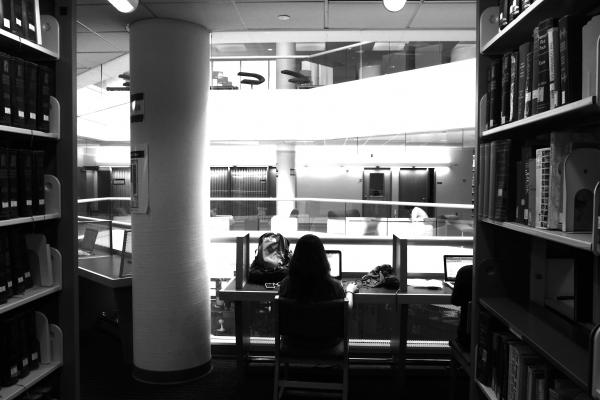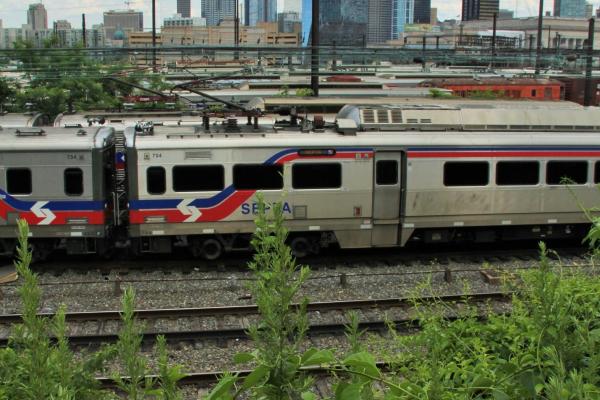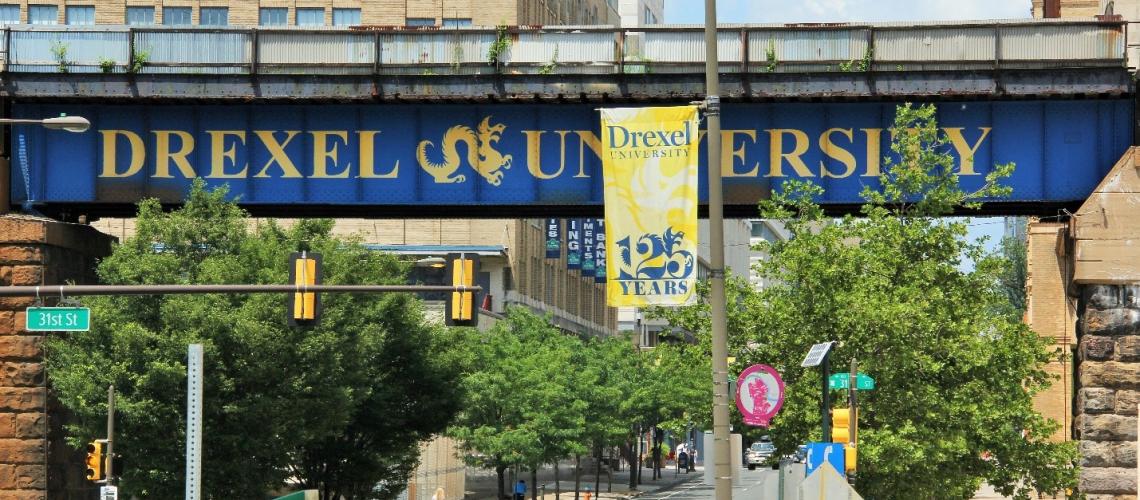Looking west on Chestnut Street at the University’s east entrance. Drexel’s brand appears on the “High Line,” which carries freight trains around 30th Street Station.
Drexel University, founded by West Philadelphian Anthony J. Drexel, has a rich history spanning over 125 years.
Founded by the Industrial Age financier Anthony J. Drexel, Drexel University—originally the Drexel Institute of Art, Science, and Industry; after that the Drexel Institute of Technology—opened in 1891 on the 3100 block of Chestnut Street. As Drexel expanded, it offered more undergraduate and graduate programs and became known for its pathbreaking “co-op” student internships. Yet Drexel's history is marked by more than its academic evolution. Plans to expand the campus in the 1960s were met with strong community resistance. In the 1970s and 1980s, Drexel entered a period of near-disastrous financial ruin compounded by declining enrollments and poor administration. But Drexel dramatically reversed its fortunes and entered the 21st century with strong new leadership. Under the banner of “co-op, urban location, technology,” Drexel opened new schools, constructed new facilities, and created community outreach and economic development programs.
Stories in this Collection
|
The Drexel Institute of Art, Science, and Industry, founded in 1891, was the brainchild of the Industrial Age financier and philanthropist Anthony J. Drexel. Drexel aimed to provide a practical education and a means of upward mobility for sons and daughters of the urban working class. Drexel donated $2 million as the fledgling Institute’s original endowment and funded the construction of a building to house the Institute—prosaically named Main Building. A Beaux Arts-style edifice architected by Wilson Brothers, Main Building was the Institute’s entire campus. Its ornamental features conveyed the Institute’s founder Anthony Drexel’s vision of working-class uplift through vocational education and exposure to high culture. |
 1900–2000 The evolution of Drexel’s academic program in the 20th century was marked each decade by one or more important developments, the first being the awarding of B.S. degrees in the 1910s and the prominence accorded engineering studies. The 1920s and 1930s saw the growth of the Institute’s path-breaking cooperative (“co-op”) program and the awarding of M.S. degrees. The 1940s witnessed the enrollment of the first class of women engineers and an emphasis on science studies in the undergraduate programs. The 1950s saw the expansion of laboratories and the introduction of graduate programs in the sciences. The 1960s were marked by the introduction of Ph.D. studies, followed by the Institute’s designation by the Commonwealth of Pennsylvania as Drexel University. The 1980s saw the introduction of personal computers, followed in the 1990s by the Internet; the latter decade saw the creation of the College of Arts and Sciences. |
1984–1994 Poor decision making and mismanagement by two presidents—William Gaither and Richard Breslin—figured prominently in the most serious sustained crisis in Drexel’s history. From 1984 to 1994, Drexel saw sharply declining enrollments (almost to the point of bankruptcy) and hostilities between faculty and university administrators. |
1995–2008 Drexel’s 12th president Constantine Papadakis (1995–2009) transformed the University from a nearly bankrupt, demoralized institution into a vital hub of education and urban revival. Governing Drexel as an entrepreneurial CEO, Papadakis restructured the University’s finances and administrative operations. He adopted a wildly successful marketing strategy that rebranded Drexel as student-centered and focused on three essentials to bolster enrollments: “co-op, urban location, technology.” Under Papadakis, a charismatic fundraiser, Drexel created medical and law schools and put up new research buildings, one of which honors his memory. |
 2010–2018 John Fry, Drexel’s president since 2010, adopted a conciliatory approach to the University’s relationship with Powelton Village—the University’s 2012 master plan, which involved the participation of students, faculty, and community residents, called for Drexel’s building upward in the campus core, not outward in Powelton Village. In 2014, Fry’s leadership team unveiled a visionary plan for a University City “Innovation Neighborhood,” which would include an eastward expansion of the Drexel campus. |
2010–2018 In the 2010s, Drexel University, in partnership with private developers, began a boom of construction projects, mainly mixed-use commercial buildings developed in partnership with private developers and involving land-lease and management contracts. Spanning the 3200 block of Chestnut Street, Chestnut Square featured two eight-story buildings that flanked the Creese Student Center, with upscale restaurants and retail businesses operating at street level. The Summit, a spectacular residential tower opened on Lancaster Avenue at Drexel in 2015, and an innovative hotel–restaurant building, the Study, opened on Chestnut Street in 2017. Opened in the spring of 2017 on the high ridge of Drexel’s eastern boundary was the mixed-use, 16-story Vue32 tower. The revenue for these commercial projects is heavily dependent on students. |
 2010–2018 Drexel launched two initiatives in the 2010s to strengthen neighborhood community development. One initiative was the fall 2016 opening of a public, university-assisted middle school, developed through a partnership with the School District of Philadelphia’s Science Leadership Academy (SLA). The new school was temporarily housed in Drexel’s Dornsife Center for Community Partnerships. Opened in 2014, the Dornsife Center is the hub for Drexel’s initiative to support economic development in Mantua. |
1957–1964 Alarmed that the Philadelphia Redevelopment Authority (RDA) earmarked all of University Redevelopment Area's Unit 1 for the University of Pennsylvania’s campus expansion, Drexel Institute of Technology’s president James Creese filed a grievance with City Council in 1957. The RDA’s coupling of Units 1 and 2 would have given Penn urban renewal rights to the entire quadrant bounded by Walnut and Chestnut from 32nd to 34th Streets. Under pressure from City Council, Penn reached an agreement with Drexel that divided Unit 1 between the two institutions, giving Drexel redevelopment (i.e., campus-expansion) rights to Unit 1B, and positioning the Institute cheek-by-jowl with Penn. |
|
1963–1967 The Drexel Institute was only marginally involved in the creation of the University City Science Center, a project of the West Philadelphia Corporation (WPC) in Unit 3, which included the blocks between 34th and 38th Streets from Powelton and Lancaster Avenues on the north to Chestnut Street on the south. Drexel’s president, William Hagerty, James Creese’s successor, resented Drexel’s second-class status vis-à-vis Penn in the WPC, the Science Center, and the larger cosmos of West Philadelphia urban renewal. |
 1964–1977 The Philadelphia Redevelopment Authority created Unit 5 of the University Redevelopment Area in 1961, with Drexel as the designated redeveloper. Drexel commissioned the firm of Nolen & Swinburne to design a master plan (called the 1970 Plan, it was completed in 1964), which projected Drexel’s campus expansion into Powelton Village. As construction of the 1970 Plan’s first building, Kelly Hall, Drexel’s first men’s dormitory, proceeded in 1965, the Institute and the Philadelphia Redevelopment Authority were at loggerheads with the Powelton Civic Homeowners Association. Other community battles over dormitory placements would follow in the coming decade and disrupt Drexel’s timetable for campus expansion. After the 1970s, community protests abated as Drexel, now a university, slowed its expansion in the face of a mounting financial crisis. |
